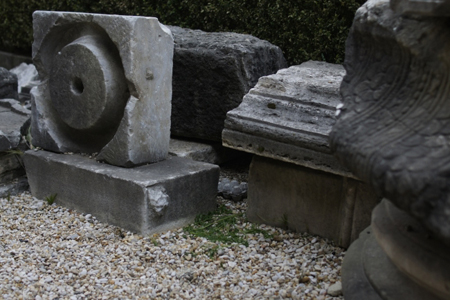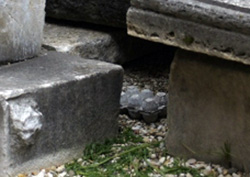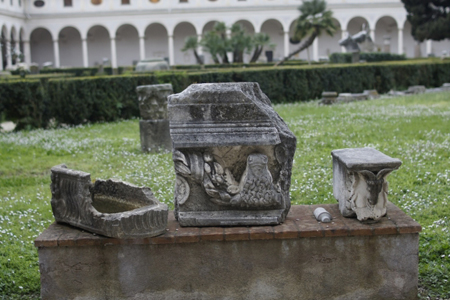Leonid Tsvetkov grabs recyclable materials out of dumpsters and trash bins—plastic bottles, Styrofoam take-out packages, cardboard egg cartoons, soda cans and more—puts them in concrete casts, and then leaves them on and around ancient Roman monuments, carvings, and inscriptions. So far, he says, nobody’s noticed them. Can you?
The idea came to him while, as a fellow at The American Academy in Rome, he was exploring the intersections of history, material culture, and consumption as they affect social and physical landscapes from antiquity until today. In his art studies, Tsvetkov realized that much of what we consider to be “artifacts” were trash in antiquity. Though egg cartons aren’t likely to be considered treasure any time soon, Tsvetkov’s work makes you think twice before sending something to the landfill. You never know, your old stuff could be a tourist attraction in a couple millennia.
THE GARBAGE PROJECT & “THE ARCHAEOLOGY OF US” by W.L.Rathje
Between 1987 and 1995, archaeologists from the Garbage Project at the University of Arizona systematically excavated, hand-sorted, measured, and recorded thirty tons of contents from fifteen landfills located across North America — from California to Toronto and from the deserts of Arizona to the everglades of Florida. The information that resulted from these digs was unexpected. In contrast to all of the concern directed at fast food packaging and disposable diapers, the archaeological data demonstrated that both items together accounted for less than 2 percent of landfill volume within refuse deposited over the last ten years. Even more surprisingly, because of industry-wide “light-weighting” — that is, making the same form of item but with less resin — plastic grocery bags had become thinner and more crushable to the point that 100 plastic bags consumed less space inside a landfill than 20 paper bags. If all three items at the center of public concern had been banned and were not replaced by anything, the garbage archaeologists were certain that landfill managers would not have noticed the difference.
At the opposite end of the contents’ spectrum were materials that occupied large portions of landfill space but received little public attention. Construction/demolition debris (C/D) was one. Because of definitional issues, C/D was not even included in the EPA’s national estimates of the refuse that goes to MSW (municipal solid waste, or standard community refuse) landfills. Like the EPA, the Garbage Project tried to avoid the issue of C/D in MSW landfills. In fact, the Garbage Project’s one sampling bias was an attempt to avoid areas where C/D was concentrated because it could easily disable expensive drilling equipment. Nevertheless, C/D accounted for 20 percent or more of excavated MSW by volume and was the second largest category of landfilled materials recovered by the Garbage Project. The largest category occupying landfill space was paper. This was true for refuse buried in the 1980s as well as for refuse dating as far back as the 1950s because in most landfills paper seemed to biodegrade very slowly. As a result, by volume nearly half of all of the refuse excavated by the Garbage Project has been newspapers, magazines, packaging paper and non-packaging paper, such as computer printouts and phonebooks.
Not long after the Garbage Project’s first reports of its landfill digs, the energy directed at passing bans was largely redirected toward “curbside recycling.” A number of communities began placing emphasis on reuse and recycling programs for C/D. Paper recycling promotions often stressed the need to keep paper out of landfills because it didn’t biodegrade as quickly as once hoped. An association of States Attorneys General determined from dig data that several products which claimed to be “biodegradable,” including some brands of disposable diapers and plastic garbage bags, did not biodegrade in landfills, and the false advertising of these products was eradicated. All of this was evidence that some crucial views of garbage held by policy planners, the media, and the public had changed — and that garbology had been validated as a new kind of archaeology.
A RATIONALE FOR THE GARBAGE PROJECT.
For as long as there have been archaeologists, there have been guesses about what these behavioral scientists would discover if they were to analyze their own society’s refuse. While often humorous, such speculations are, in fact, based on a serious rationale: If archaeologists can learn important information about extinct societies from patterns in ancient garbage, then archaeologists should be able to learn important information about contemporary societies from patterns in fresh garbage. The pieces of pottery, broken stone tools, and cut animal bones which traditional archaeologists dig out of old refuse middens provide a surprisingly detailed view of past lifeways, just as all the precisely labeled packages and the food debris and the discarded clothing and batteries in modern middens reveal the intimate details of our lives today. If indeed there are useful things to learn from our garbage — things which can enrich human lives and minimize the undesirable environmental consequences of the industrialized world — why wait until we are all dead and buried to find them out? Garbology now! At least that is what Dr. Bill Rathje and a group of students thought when they founded the Garbage Project at the U of AZ in the Spring of 1973. Today, Rathje and the Project, including co-director Wilson Hughes who was one of the founding students, are still thinking along these same lines.
Over the last 23 years the Garbage Project has literally immersed itself in fresh refuse placed out for collection and in materials exhumed from landfills. Fresh discards are recorded in order to study food waste, what people eat and drink, recycling behaviors, household hazardous wastes, packaging discards, and even the relation between fluoride and tooth decay. In 1987, when the Garbage Project added the excavation of landfills to its research repertoire, investigations focused on the composition of landfilled wastes, the rate of breakdown of these materials within landfills, the contribution of residential hazardous wastes to the leachate (or fluids) which leak out of MSW landfills, and the impact of various waste reduction strategies — recycling, composting, “source reduction” (which just means “using less stuff” in the first place) — on what wastes are landfilled. Today, the Garbage Project’s fresh refuse records, compiled from the long-term ongoing study in Tucson, AZ, and short-term studies in five other cities, form a one-of-a-kind database which currently encompasses 23 years of time depth.
Abstracts of an article originally appeared as Rathje, WL. The archaeology of us. In Ciegelski, C.(ed.), Encyclopaedia Britannica’s Yearbook of Science and the Future–1997 (New York, Encyclopaedia Britannica), 158-177, 1996.


